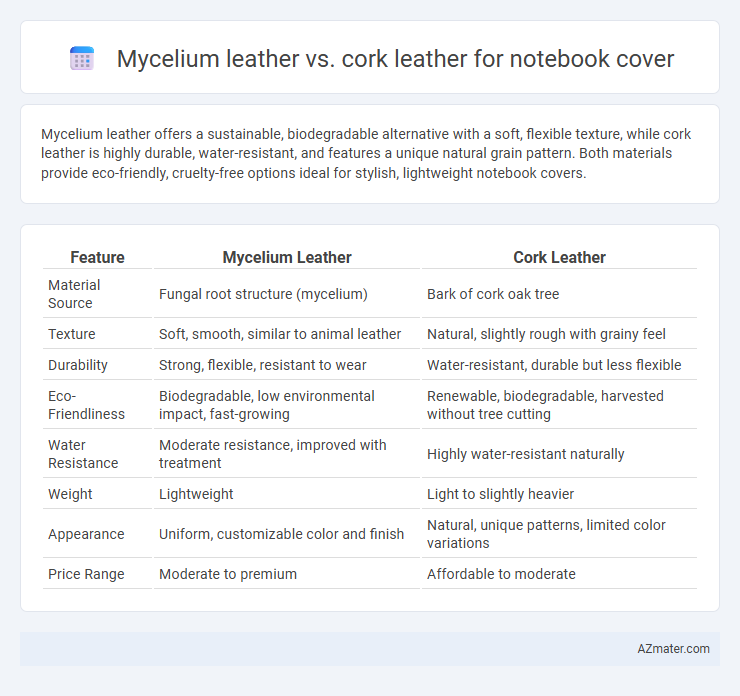Mycelium leather offers a sustainable, biodegradable alternative with a soft, flexible texture, while cork leather is highly durable, water-resistant, and features a unique natural grain pattern. Both materials provide eco-friendly, cruelty-free options ideal for stylish, lightweight notebook covers.
Table of Comparison
| Feature | Mycelium Leather | Cork Leather |
|---|---|---|
| Material Source | Fungal root structure (mycelium) | Bark of cork oak tree |
| Texture | Soft, smooth, similar to animal leather | Natural, slightly rough with grainy feel |
| Durability | Strong, flexible, resistant to wear | Water-resistant, durable but less flexible |
| Eco-Friendliness | Biodegradable, low environmental impact, fast-growing | Renewable, biodegradable, harvested without tree cutting |
| Water Resistance | Moderate resistance, improved with treatment | Highly water-resistant naturally |
| Weight | Lightweight | Light to slightly heavier |
| Appearance | Uniform, customizable color and finish | Natural, unique patterns, limited color variations |
| Price Range | Moderate to premium | Affordable to moderate |
Introduction to Mycelium and Cork Leather
Mycelium leather, derived from the root structure of mushrooms, offers a sustainable and biodegradable alternative to traditional animal leather with a unique, natural texture ideal for notebook covers. Cork leather, harvested from the bark of cork oak trees, is lightweight, water-resistant, and eco-friendly, providing durability and a distinct grain pattern that enhances the aesthetic and tactile experience. Both materials support environmentally conscious choices by reducing reliance on animal products and minimizing ecological impact.
Sustainable Sourcing and Eco-Friendliness
Mycelium leather for notebook covers is derived from mushroom root structures, offering a rapidly renewable resource that decomposes naturally and reduces reliance on animal hide and synthetic plastics. Cork leather, harvested from the bark of cork oak trees without harming the tree, provides a sustainable, biodegradable, and water-resistant material that supports forest ecosystems and carbon sequestration. Both materials eliminate harmful chemicals used in traditional leather tanning, but mycelium's faster cultivation cycle gives it a slight edge in eco-friendliness and scalable sustainable sourcing.
Production Processes Compared
Mycelium leather for notebook covers is produced through the cultivation of fungal mycelium grown on agricultural waste, resulting in a sustainable and biodegradable material with low energy consumption. Cork leather production involves harvesting bark from cork oak trees without tree felling, followed by processing and binding to form a durable, water-resistant material that requires minimal chemical treatments. Both processes emphasize eco-friendliness, yet mycelium leather offers faster renewability due to its rapid growth cycle compared to the slower regeneration of cork bark.
Material Durability and Longevity
Mycelium leather offers high durability due to its dense fibrous network, making it resistant to wear and tear over time. Cork leather provides excellent longevity as it is naturally water-resistant and flexible, preventing cracking and deterioration. Both materials deliver sustainable, long-lasting protection for notebook covers, with mycelium excelling in toughness and cork in resilience against environmental factors.
Aesthetic Appeal and Texture Differences
Mycelium leather offers a velvety, suede-like surface with rich, natural fibers giving a luxurious and organic aesthetic, while cork leather presents a smooth, matte finish with a unique grain pattern that evokes rustic sophistication. The texture of mycelium leather is soft and pliable, enhancing tactile comfort, whereas cork leather is firmer and slightly textured, providing durability and a distinct sensory experience. Both materials deliver eco-friendly alternatives with contrasting visual and tactile qualities, catering to diverse notebook cover preferences.
Weight and Flexibility
Mycelium leather offers lightweight properties with a soft, flexible texture that adapts well to bending, making it ideal for notebook covers requiring durability and comfort. Cork leather is slightly heavier but provides excellent flexibility and natural water resistance, lending added protection for everyday use. Both materials balance sustainability with functional performance, though mycelium's lower weight may enhance portability.
Water Resistance and Maintenance
Mycelium leather offers superior water resistance compared to cork leather, making it highly effective at repelling moisture and protecting notebook covers from accidental spills. Cork leather, while naturally water-repellent due to its cellular structure, requires periodic sealing to maintain its resistance and prevent damage over time. Mycelium's dense, fibrous composition demands minimal maintenance, whereas cork leather benefits from regular conditioning to sustain its durability and appearance.
Cost and Market Availability
Mycelium leather for notebook covers tends to be more expensive due to its innovative production process and limited market availability, whereas cork leather is generally more affordable and widely accessible as a sustainable material. Cork leather benefits from well-established supply chains primarily in Portugal and Spain, making it a cost-effective choice for eco-friendly notebook covers. The emerging demand for mycelium leather is driving gradual market expansion, but it remains less prevalent and often commands a premium price compared to cork.
Environmental Impact and Biodegradability
Mycelium leather, derived from fungal root networks, offers a highly sustainable alternative with rapid growth cycles and minimal resource input, significantly reducing carbon footprint compared to traditional materials. Cork leather, harvested from the bark of cork oak trees, promotes biodiversity and supports carbon sequestration while being renewable and biodegradable. Both materials exhibit excellent biodegradability, but mycelium leather decomposes faster due to its organic fungal composition, making it a superior eco-friendly choice for notebook covers.
Choosing the Best Leather Alternative for Notebook Covers
Mycelium leather offers exceptional durability and a soft, flexible texture, making it an ideal choice for notebook covers that require long-lasting protection and a premium feel. Cork leather provides a lightweight, water-resistant, and eco-friendly option with a unique natural grain, perfect for users prioritizing sustainability and distinct aesthetics. Comparing both materials, mycelium leather excels in robustness and organic appeal, while cork leather stands out for its renewable sourcing and moisture resistance, guiding consumers based on their specific durability and environmental preferences.

Infographic: Mycelium leather vs Cork leather for Notebook cover
 azmater.com
azmater.com